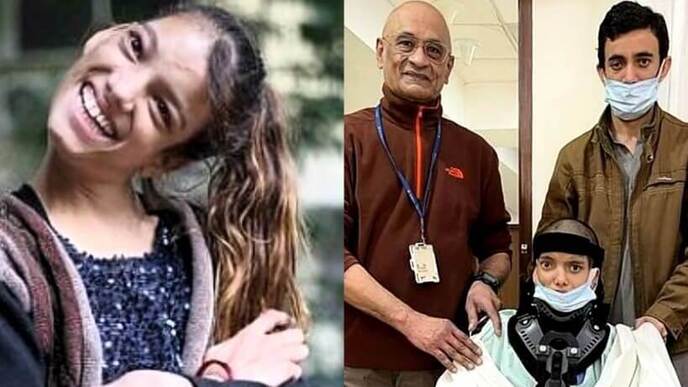13 year old girl from Pakistan with neck bent at 90 degrees (resulting from a rare muscular condition) undergoes ‘successful’ life-changing surgery to straighten her neck at Indraprastha Apollo Hospitals, New Delhi
She was detected with dropped head syndrome & a neglected/progressive cerebral palsy
6th April, New Delhi: Suffering from a rare muscular condition, 13 year old girl from Pakistan with head bent at 90 degrees, was successfully operated at Indraprastha Apollo Hospitals, New Delhi.
Extremely rare condition commonly termed as “dropped head syndrome” is a chin-on-chest deformity in which the head drops forward due to lack of support from the muscles of the neck and can be caused by a variety of neuromuscular or other disorders. The 13 year old’s case had gotten complicated over the years due undiagnosed, neglected, progressive dislocation at the cranio-cervical junction aggravated by the cervical dystonia of her cerebral palsy.
After getting hurt on the neck as an infant, her neck had gotten stuck at 90 degrees. Only recently her family reported that her condition had deteriorated in the past few years- she would get breathless walking short distances, speech and hearing abilities had gotten impaired. She was admitted to Indraprastha Apollo Hospitals under the supervision of Dr Rajagopalan Krishnan, Senior Consultant Orthopedics, Spine Surgery and Joint Replacement, Indraprastha Apollo Hospitals, who immediately recommended medical intervention first in the form of a halo-gravity therapy followed by a surgical procedure. Any kind of delay could have left the girl paralyzed from the neck down or would have been life threatening caused due respiratory failure.
Leading the case, Dr Rajagopalan Krishnan, Senior Consultant Orthopedics, Spine Surgery and Joint Replacement, Indraprastha Apollo Hospitals, said, ‘The whole surgery was high risk due to multiple and complex pathology in this child with undiagnosed cerebral palsy, undiagnosed cranio-cervical dislocation, severe spinal cord compression, cervical myelopathy, respiratory impairment, fragile skin, poor nutrition etc.
On admission we first put her on halo-gravity therapy before directly doing the surgery. This therapy was essential because the deformity had been fixed for 12 years and we wanted to first do a gradual supervised stretching. This was mandatory because the dislocation had caused severe spinal cord compression, cervical myelopathy and syrinx in the cervico-medullary spinal cord and a direct surgery would have posed risk to life.
Once the body responded to this procedure positively we did a 6 hour surgery (cranio-cervical surgery) to bring the left side dropped head up to centre position over the body, fix the corrected head/neck/trunk position in place with instrumentation and bony fusion.’



